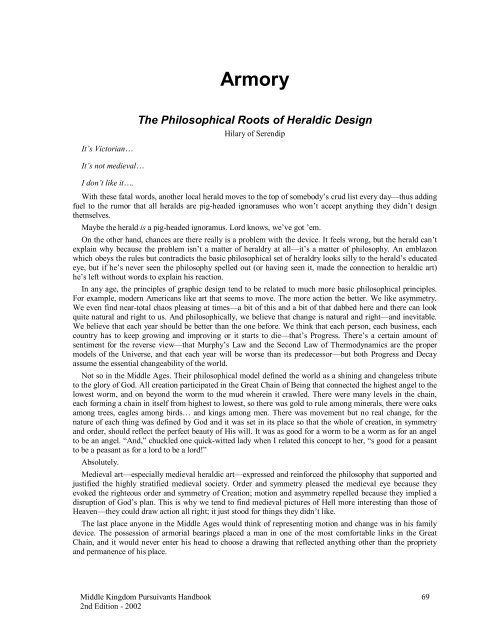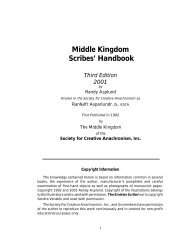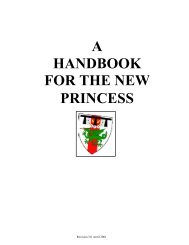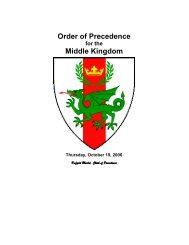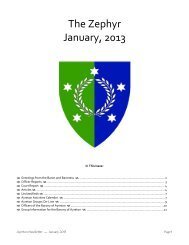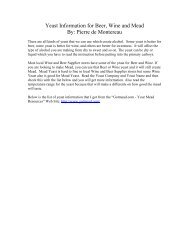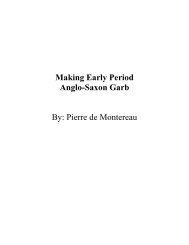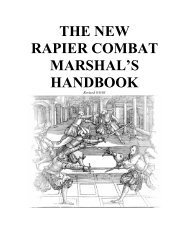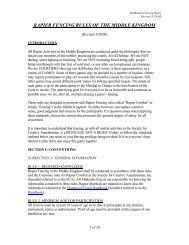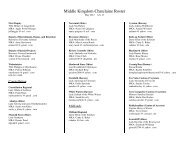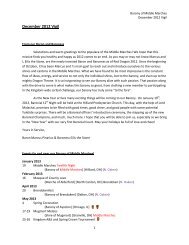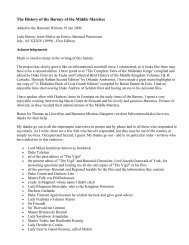Middle Kingdom Pursuivants Handbook 2nd Edition - Midrealm ...
Middle Kingdom Pursuivants Handbook 2nd Edition - Midrealm ...
Middle Kingdom Pursuivants Handbook 2nd Edition - Midrealm ...
You also want an ePaper? Increase the reach of your titles
YUMPU automatically turns print PDFs into web optimized ePapers that Google loves.
ArmoryThe Philosophical Roots of Heraldic DesignHilary of SerendipIt’s Victorian…It’s not medieval…I don’t like it….With these fatal words, another local herald moves to the top of somebody’s crud list every day—thus addingfuel to the rumor that all heralds are pig-headed ignoramuses who won’t accept anything they didn’t designthemselves.Maybe the herald is a pig-headed ignoramus. Lord knows, we’ve got ’em.On the other hand, chances are there really is a problem with the device. It feels wrong, but the herald can’texplain why because the problem isn’t a matter of heraldry at all—it’s a matter of philosophy. An emblazonwhich obeys the rules but contradicts the basic philosophical set of heraldry looks silly to the herald’s educatedeye, but if he’s never seen the philosophy spelled out (or having seen it, made the connection to heraldic art)he’s left without words to explain his reaction.In any age, the principles of graphic design tend to be related to much more basic philosophical principles.For example, modern Americans like art that seems to move. The more action the better. We like asymmetry.We even find near-total chaos pleasing at times—a bit of this and a bit of that dabbed here and there can lookquite natural and right to us. And philosophically, we believe that change is natural and right—and inevitable.We believe that each year should be better than the one before. We think that each person, each business, eachcountry has to keep growing and improving or it starts to die—that’s Progress. There’s a certain amount ofsentiment for the reverse view—that Murphy’s Law and the Second Law of Thermodynamics are the propermodels of the Universe, and that each year will be worse than its predecessor—but both Progress and Decayassume the essential changeability of the world.Not so in the <strong>Middle</strong> Ages. Their philosophical model defined the world as a shining and changeless tributeto the glory of God. All creation participated in the Great Chain of Being that connected the highest angel to thelowest worm, and on beyond the worm to the mud wherein it crawled. There were many levels in the chain,each forming a chain in itself from highest to lowest, so there was gold to rule among minerals, there were oaksamong trees, eagles among birds… and kings among men. There was movement but no real change, for thenature of each thing was defined by God and it was set in its place so that the whole of creation, in symmetryand order, should reflect the perfect beauty of His will. It was as good for a worm to be a worm as for an angelto be an angel. “And,” chuckled one quick-witted lady when I related this concept to her, “s good for a peasantto be a peasant as for a lord to be a lord!”Absolutely.Medieval art—especially medieval heraldic art—expressed and reinforced the philosophy that supported andjustified the highly stratified medieval society. Order and symmetry pleased the medieval eye because theyevoked the righteous order and symmetry of Creation; motion and asymmetry repelled because they implied adisruption of God’s plan. This is why we tend to find medieval pictures of Hell more interesting than those ofHeaven—they could draw action all right; it just stood for things they didn’t like.The last place anyone in the <strong>Middle</strong> Ages would think of representing motion and change was in his familydevice. The possession of armorial bearings placed a man in one of the most comfortable links in the GreatChain, and it would never enter his head to choose a drawing that reflected anything other than the proprietyand permanence of his place.<strong>Middle</strong> <strong>Kingdom</strong> <strong>Pursuivants</strong> <strong>Handbook</strong> 69<strong>2nd</strong> <strong>Edition</strong> - 2002


